Homemade tomato sauce doesn't have to mean hours of stirring and monitoring. The slow, gentle heat of a crockpot creates remarkably rich, complex tomato sauce with minimal hands-on time. Unlike traditional stovetop methods that risk scorching or uneven cooking, the crockpot's consistent low temperature allows flavors to meld beautifully while you attend to other tasks.
Why Crockpot Tomato Sauce Beats Stovetop Every Time
Food science explains why slow cooking transforms basic tomato sauce into something extraordinary. The USDA's National Center for Home Food Preservation confirms that low-temperature cooking preserves more volatile flavor compounds that evaporate during rapid boiling. This gentle process allows enzymatic reactions to develop deeper umami notes without the risk of burning that plagues stovetop methods.
| Preparation Method | Active Time | Flavor Complexity | Risk of Burning |
|---|---|---|---|
| Crockpot (8 hours) | 15 minutes | ★★★★★ | Low |
| Stovetop (3 hours) | 60+ minutes | ★★★☆☆ | High |
| Pressure Cooker (45 min) | 20 minutes | ★★★☆☆ | Medium |
Essential Ingredients for Perfect Flavor Balance
The magic happens through proper ingredient selection. According to culinary research from America's Test Kitchen, the acid-sugar balance in tomatoes varies significantly by variety. San Marzano tomatoes consistently deliver the ideal 3:1 sugar-to-acid ratio that creates naturally balanced sauce without added sugar.
Your ingredient checklist:
- 28 oz canned San Marzano tomatoes (preferably DOP-certified)
- 3 cloves garlic, smashed (not minced - prevents bitterness)
- 1 small yellow onion, quartered
- 2 tbsp olive oil (extra virgin for finishing)
- 5 fresh basil leaves (plus more for finishing)
- 1 tsp dried oregano
- Pinch of red pepper flakes (optional)
- Salt to taste (start with 1/2 tsp)

Step-by-Step Crockpot Preparation
Follow this professional chef technique for flawless results every time:
- Prep work (5 minutes): Drain tomatoes, reserving 1/4 cup liquid. Smash garlic cloves (keeps them intact to prevent bitterness).
- Layer ingredients: Place onion quarters and garlic at bottom of crockpot, then add tomatoes, basil, oregano, red pepper flakes, and olive oil.
- Cooking process: Set to LOW for 7-8 hours (never HIGH - causes uneven cooking). Do not stir during cooking.
- Finishing touches: Remove garlic and onion pieces. Stir in reserved tomato liquid and fresh basil. Season with salt.
- Texture adjustment: For smoother sauce, use immersion blender for 10 seconds (never traditional blender with hot liquid).
Troubleshooting Common Issues
Even perfect recipes encounter challenges. Here's how to fix them:
- Too watery? Remove lid for final 30-60 minutes of cooking to allow evaporation. Never add thickeners - proper reduction creates better texture.
- Too acidic? Add 1/4 teaspoon baking soda (not sugar) to neutralize acidity without altering flavor profile.
- Bland flavor? Finish with high-quality extra virgin olive oil and fresh herbs - heat destroys delicate aromatic compounds.
- Separation occurring? This is normal with slow cooking. Simply stir gently before serving.
Creative Variations Worth Trying
Once you've mastered the basic crockpot tomato sauce, experiment with these chef-approved variations:
- Roasted Vegetable: Add 1/2 cup roasted carrots and celery before cooking for natural sweetness
- Puttanesca Style: Stir in 2 tbsp capers, 1/4 cup olives, and 3 anchovy fillets after cooking
- Arrabbiata: Double the red pepper flakes and add 1/4 tsp smoked paprika
- Creamy Tomato: Whisk in 1/4 cup heavy cream just before serving (never during cooking)
Storage and Usage Tips
Proper storage maintains quality and flavor. According to the National Center for Home Food Preservation, tomato sauce freezes exceptionally well due to its acidity:
- Refrigeration: Store in airtight container for up to 5 days (flavor improves on day 2)
- Freezing: Portion into ice cube trays, then transfer to freezer bags (keeps 6 months)
- Canning: Requires proper acidification - add 1 tbsp lemon juice per pint before water bath canning
- Reheating: Always reheat gently over low heat to preserve flavor compounds
When Not to Use Your Crockpot for Tomato Sauce
While crockpot tomato sauce excels in most situations, certain circumstances call for alternative methods:
- Urgent time constraints: When you need sauce in under 2 hours, stovetop with constant attention works better
- Very small batches: For single servings, the crockpot's surface area-to-volume ratio prevents proper reduction
- Adding delicate ingredients: Fresh seafood or quick-cooking vegetables should be added at the end using stovetop method
- When precise texture control is critical: Certain pasta dishes require specific sauce consistency that's easier to control on stovetop











 浙公网安备
33010002000092号
浙公网安备
33010002000092号 浙B2-20120091-4
浙B2-20120091-4